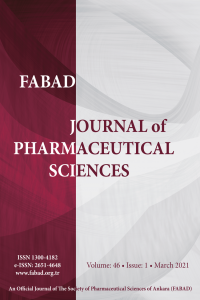Anticancer Potential of Novel Nanoemulgel Formulations in Melanoma
Anticancer Potential of Novel Nanoemulgel Formulations in Melanoma
Nanoemulsion, nanoemulgel, melanoma, cancer drug delivery systems,
___
- Alam, M., Rizwanullah, M., Mir, S.R., Amin, S. (2023). Promising prospects of lipid-based topical nanocarriers for the treatment of psoriasis. OpenNano, 10, 100123. doi: 10.1016/j.onano.2023.100123
- Alcindor, T., & Beauger, N. (2011). Oxaliplatin: a review in the era of molecularly targeted therapy. Curr Oncol, 18(1), 18-25. doi:10.3747/co.v18i1.708
- ISSN: 1300-4182
- Yayın Aralığı: Yılda 3 Sayı
- Başlangıç: 2005
- Yayıncı: FABAD Ankara Eczacılık Bilimleri Derneği
Drug Administration via Feeding Tube in Intensive Care Unit: A Cross-sectional Study
Nursel SURMELİOGLU, Yaren İLERİ, H Murat GÜNDÜZ, Dilek ÖZCENGİZ
Yeni Parasetamol-Triazol Konjugatlarının Sentezi ve Biyolojik Değerlendirmesi
Necla KULABAŞ, Merve GÜRBOĞA, Özlem BİNGÖL ÖZAKPINAR, Jianyang LİU, Per-johan JAKOBSSON, Özkan DANIŞ, Ayşe OGAN, İlkay KÜÇÜKGÜZEL
Development and Characterization of Nanofiber Strip Containing Sertraline for Buccal Application
Kutsal ÖZCAN, Sibel İLBASMIŞ TAMER, Eylül Su SARAL ACARCA
Mucoadhesive Drug Delivery Systems for Pediatric and Geriatric Patients
Arya RAİ, Shristhi Sohan RAWAT, Ritu RATHİ, Deepika RAİNA, Oluwatoyin A. ODEKU, Inderbir SİNGH
Yaren KAHVECİ, İnci Selin DOĞAN, Şeyda KANBOLAT, Bahittin KAHVECİ
Çağatay OLTULU, Melek AKINCI, Elvan BAKAR
NLRP3 expression in peripheral blood mononuclear cells of patients with rheumatoid arthritis
Sezen YILMAZ SARIALTIN, Orhan KÜÇÜKŞAHİN, Cemil NURAL, Leyla Didem KOZACI, Pınar KAYGIN, Gülçin GÜLER ŞİMŞEK, Serpil OĞUZTÜZÜN, Tülay ÇOBAN
Üçlü negatif meme kanseri hücrelerine folik asit polietilenimin polipleksleri ile gen aktarımı
